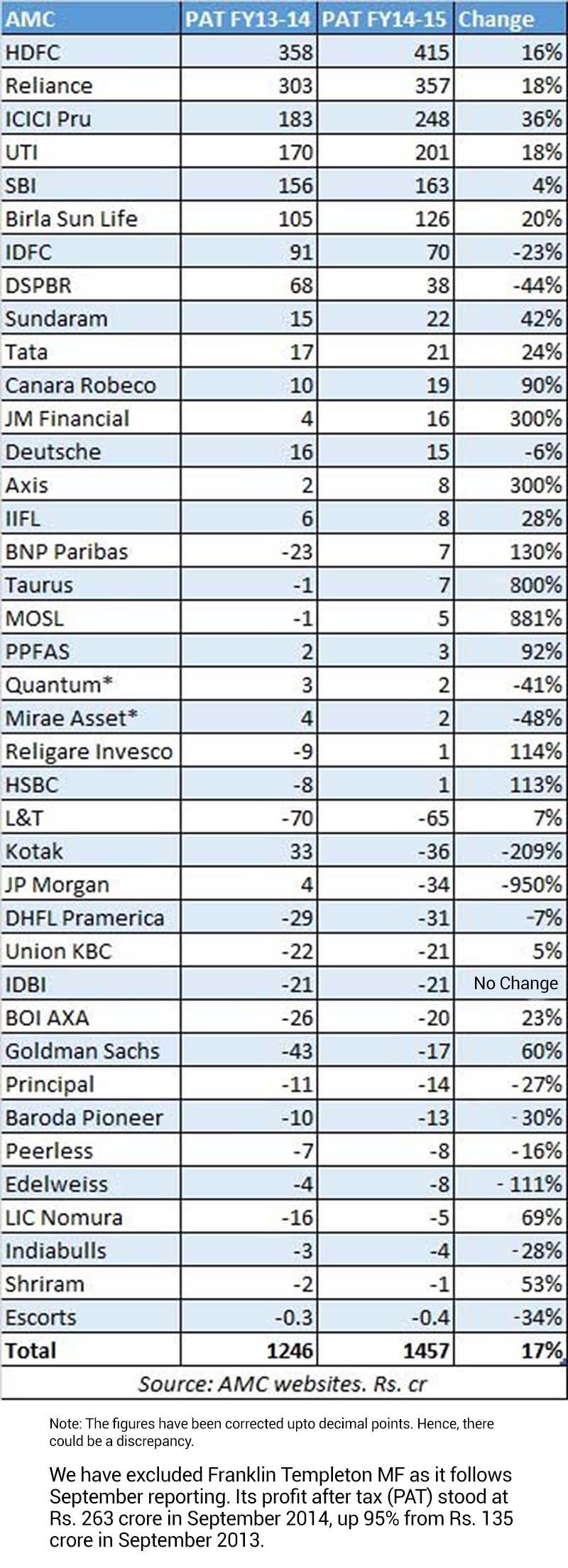An analysis of profit figures of AMCs shows that 16 out of 39 AMCs reported losses in FY14-15.
 These 16 AMCs accumulated losses of Rs. 298 crore in FY14-15, up 32% as compared to Rs. 226 crore the previous fiscal.
These 16 AMCs accumulated losses of Rs. 298 crore in FY14-15, up 32% as compared to Rs. 226 crore the previous fiscal.
A few of them like Union KBC, Indiabulls and Shriram are recent entrants and thus yet to break-even.
To break-even, they are trying to grow organically with a focus on keeping costs under control. “Profitability is one of our main focus areas. We want to make sure that our equity funds turn profitable in two years. Even in the debt category, we won’t take a hit on losses to ramp up our AUM. We hope to break-even in the next three years,” said G Pradeepkumar, CEO, Union KBC Mutual Fund.
Pradeepkumar says that his fund house would consider venturing in offshore advisory after building a five year track record in equity.
AMC fortunes are closely tied to equity markets. Thus, they say that it is difficult to make a projection of break-even and profitability. “Markets have been supportive since 2013 which has helped AMCs. We are aiming to break-even in the next three years by focusing on building equity and hybrid assets. However, we can’t project the exact mix of equity and debt which will drive our profitability. AMCs change their strategies based on market conditions, says D Ramanathan, Head – Sales & Marketing, Shriram AMC.
Among the AMCs which booked losses, L&T reported the highest loss at Rs. 65 crore, though its losses fell from Rs. 70 crore in FY13-14 to Rs.65 crore in FY14-15. However, the loss is due to amortization of expenses relating to acquisition of Fidelity Mutual Fund. “The industry has made profits last year as the markets have bounced back. Though our profit and loss statement shows that we are in a red, operationally, we are a profitable fund house. Going ahead, we expect to increase our profit at a healthy pace,” said Kailash Kulkarni, CEO, L&T Mutual Fund.
After L&T, Kotak booked the second highest loss at Rs. 36 crore. Kotak has been a profitable fund house but it booked losses to increased distribution expenditure last fiscal. Kotak AMC had seen a market share of 5% on the net equity inflows during FY14-15, backed by very good performance of equity funds. Kotak AMC also has done exceedingly well in the equity arbitrage category and has seen a market share of around 19% on AAUM for FY 14-15. This increase in the market share resulted in a substantive jump in the upfront brokerage and other distribution expenses. The business promotion, distribution and mutual fund expenses increased by Rs. 37 crore as compared to the previous year,” states Kotak AMC annual report.
JP Morgan booked the third highest loss at Rs. 34 crore due to increased expenditure. Its expenditure went up from Rs. 52 crore in FY13-14 to Rs. 93 crore in FY14-15.
Sources of revenue
Fund houses earn from domestic funds, PMS and offshore advisory. The two sources of revenue for AMCs are ‘income from operations’ and ‘other income’. Income from operations include investment management fees, advisory fees and income from PMS fee. Income from ‘other sources’ include dividend income, gain on sale of assets, interest income, etc. Some fund houses derive a large portion of income from PMS and offshore advisory.
For instance, Motilal Oswal earned 87% of its operational revenue from PMS fee. IIFL received 97% of operational revenue from Alternate Investment Fund and Venture Fund. This helped IIFL AMC clock a net profit of Rs. 8 crore last fiscal. Similarly, Quantum AMC received 74% of its operational revenue from research and advisory services to offshore clients. (*Quantum AMC follows June financial year. The results reported for March 2015 are for nine months.)
HSBC MF received 53% revenue from PMS and advisory fees. Also, Mirae and Tata MF received a good chunk of operational revenues from offshore advisory.
(Mirae Asset has changed its financial year from April-March to January-December.) Mirae Asset reported a net profit of Rs. 2 crore last fiscal.
Large fund houses like HDFC and ICICI Pru also have PMS business but they get majority of revenues from domestic mutual funds.
Top 10 AMCs
Large AMCs recorded a robust growth in profitability due to the bounce back in markets last fiscal. The markets had risen 25% last fiscal.
Among the top 10 AMCs, Sundaram AMC recorded the highest growth in PAT in percentage terms. Its PAT grew by 42% from Rs. 15 crore in FY13-14 to Rs. 22 crore in FY14-15. Its AUM grew by 26% from Rs. 15,193 crore to Rs. 19,116 crore last year. Sundaram Mutual Fund launched 27 schemes (7 fixed term plans, 2 hybrid funds, 17 close-ended equity schemes and 1 open-ended debt scheme) which mobilized Rs. 1,381 crore.
ICICI Pru clocked the second highest growth at 36% as its PAT grew from Rs. 183 crore to Rs. 248 crore during the same period. The fund house mopped up Rs. 11,650 crore through 51 fixed maturity plans, 19 capital protection oriented schemes, 15 multiple yield funds, 12 close ended equity funds, two open ended equity funds and one open ended debt fund launched last fiscal. ICICI Pru AMC’s AAUM grew by 40% from Rs. 1.06 lakh crore to Rs. 1.48 lakh crore during the same period.
DSP BlackRock and IDFC AMC recorded a drop in their profits. DSPBR’s PAT dipped from Rs. 68 crore to Rs. 38 crore during the same period due to increase in expenditure, which increased from Rs. 176 crore to Rs. 286 crore last fiscal.
Similarly, IDFC AMC’s PAT declined from Rs. 91 crore to Rs. 70 crore.
Cost and asset mix
Fund houses earn from the total expense ratio charged on schemes. Equity funds, which charge higher expenses as compared to debt funds, are more profitable for fund houses. The industry received net inflows of Rs. 1.03 lakh crore in FY14-15. Of this, 69% or Rs. 71,030 crore has come in equity funds, which helped majority of AMCs grow their PAT.
There are two main factors which determine the profitability of AMCs – cost structure and the asset mix.
“It depends from one AMC to another. Suppose AMC ‘A’ spends Rs. 100 crore in 6 years and AMC ‘B’ spends Rs. 200 crore in 3 years as distribution and marketing expense, the latter will achieve operational profitability earlier. But the payback time, in terms of PAT, will be longer for AMC B,” points out the CEO of a mid-sized AMC.
The employee strength and pay structure of AMCs also determines the profitability of AMCs. “Although Fidelity had a large equity AUM its employee cost was high,” says a Mumbai based distributor.
AUM and PAT growth
The industry’s assets under management went up by 15% from Rs. 9.45 lakh crore to Rs. 10.82 lakh crore last fiscal. All in all, the industry recorded a PAT of Rs. 1,457 crore in FY14-15, up 17% from Rs. 1,246 crore the previous fiscal.




